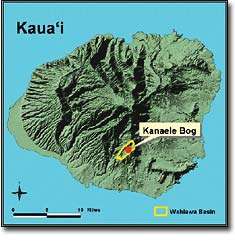A rare Hawaiian plant community in the 80-acre Kanaele bog located above Kalaheo town will be protected due to a 10-year agreement between The Nature Conservancy of Hawaii and a Kaua‘i-based subsidiary of Alexander & Baldwin. The memorandum of understanding
A rare Hawaiian plant community in the 80-acre Kanaele bog located above Kalaheo town will be protected due to a 10-year agreement between The Nature Conservancy of Hawaii and a Kaua‘i-based subsidiary of Alexander & Baldwin.
The memorandum of understanding is allowing Conservancy representatives to build a fence around the bog to prevent pigs from entering it to allow the natural regeneration of native plants, Conservancy representatives said in a news release.
Invasive plants also would be removed from the protected bog area. Invasion of the bog by invasive plants, such as the strawberry guava, poses the greatest threat to native plants, Conservancy representatives said.
The bog is home to such endangered plants as the “showy haha-‘ai-a-ka-manu, which features cream-colored flowers streaked with purple, and the oha wai.”
Other rare plants to be saved would be the na‘ena‘e, kamakahala, Viola helenae and the Hesperomannia lydgatei, The Conservancy said.
The fence also would prevent feral animals and pigs from entering into the area.
“Bogs are especially susceptible to damage from rooting pigs,” Conservancy field representative Allan Rietow said in a statement. Pigs favor the moist soil for digging.
As part of the agreement, representatives for The Conservancy will monitor, collect data, maintain the fence, control alien threats and perform management functions.
Trae Menard, The Conservancy’s first resources manger for Kaua‘i, is to oversee the project.
The U.S. Fish and Wildlife Service, The Conservancy and other groups will share the cost for the project, which are estimated to be between $80,000 to $120,000.
In a news release, Suzanne Case, executive director of The Conservancy, said the bog is the only known “well-preserved, low-elevation bog left in the state.”
Sam Gon, director of science for The Nature Conservancy, said many rare plants are found in the bog and in surrounding Wahiawa Basin and that “Kanaele is an ecologist’s gem.”
Case noted “this unique bog and native plant community has somehow withstood the invasion of feral pigs and invasive alien plants that have degraded most of the area south of it.”
“Thanks to Alexander and Baldwin, we will now be able to work to ensure its protection,” Case said.
Alexander and Baldwin Vice President Meredith Ching said the bog has been an important water source for A&B’s businesses on Kaua‘i for years.
“Through the years, we have also learned how distinctive and valuable Kanaele is from a biological standpoint, and we are pleased to partner with The Nature Conservancy and others to pursue our common goal of ensuring that this resource is protected for generations to come,” Ching said a statement.
Many areas in Hawai‘i below the 3,000-foot elevation have been converted to agriculture, but the Kanaele bog has avoided that fate because it was regarded as an important water source by for agriculture, Gon said.
“The Kanaele bog is one of those areas that is special…and Alexander and Baldwin and The Nature Conservancy have been talking about preserving the bog for years,” Gon said.
The bog sits at an elevation of 2,100 feet and is located in the mountains above Kalaheo town.
The bog is located in the Wahiawa Drainage basin, which is an important watershed and source of the Wahiawa Stream and the Alexander Reservoir, which is owned by McBryde Sugar Company, an A&B subsidiary.
The bog receives an annual rainfall of 161 inches.
Hawaiian bogs are relatively few in numbers. The principal bogs in Hawai‘i are the Alaka‘i plateau and the Kanaele bog on Kaua‘i, Pepe‘opae and Pu‘u Ali‘i bogs on Moloka‘i, the Hana rainforest bogs in East Maui and the Pu‘u Kukui in West Maui and the Kohala bogs on the Big Island.
Staff writer Lester Chang can be reached at 245-3681 (ext. 225) and mailto:lchang@pulitzer.net


